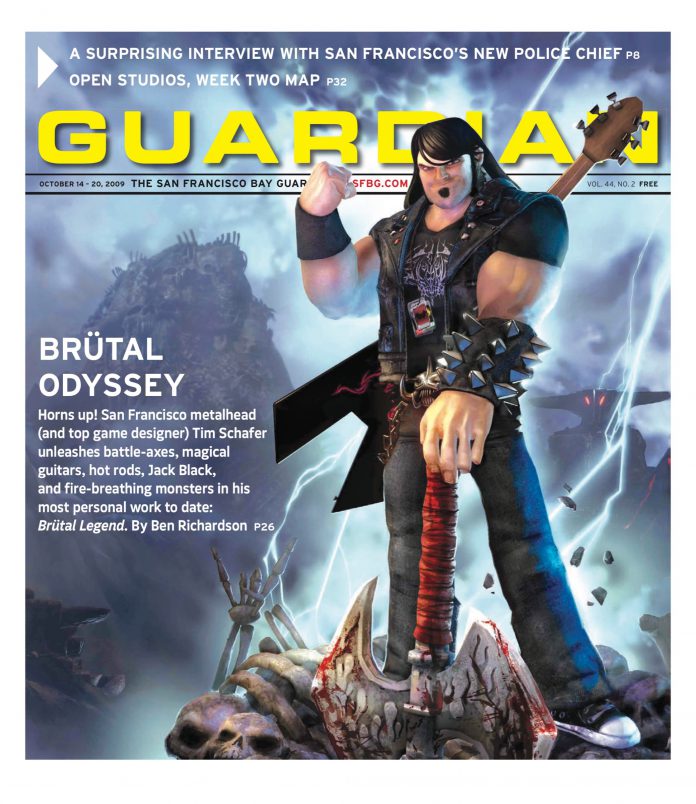GREEN CITY David Addington presents a tempting vision for revitalizing the seedy mid-Market area, a kind of something-for-nothing deal that helps the children, property owners, and residents of the Tenderloin and relieves that burden from the cash-strapped city government.
All we, as San Francisco voters, have to do is accept a few new billboards, which voters banned in 2002 by passing Proposition G. Well, actually, more than a few. More like a cacophony of flashy and interconnected electronic signs and large billboards on top of the area’s 52 buildings. Proposition D, which Addington wrote and sponsors, would allow an unlimited number of business and general advertising signs along Market Street between Fifth and Seventh streets.
"I’m not afraid of signs," Addington says in his Southern drawl as we walk the neighborhood where he owns the Warfield Theater, the old Hollywood Billiards building, and the new Show Dogs gourmet hot dog joint next to the Golden Gate Theater, and where he seems to know everyone from scruffy street souls to his fellow business people.
As Addington points out, this is the most dilapidated stretch of Market Street, rife with vacant storefronts and cheap retail outlets, but bordered by U.N. Plaza on one side and the bustling Westfield Mall and Powell Street cable car stop on the other. It’s a two-block stretch that is neglected and ignored by much of the outside world.
"To change that, you’re going to have to make a dramatic visual presentation," Addington said, laying out a vision of a glitzy, twinkling theater district that lights up the neighborhood and beckons visitors. And the kicker is that by doing so, advertisers would pour millions of dollars of revenue into improving and promoting the neighborhood.
Property owners would get most of that money: 60 percent for most of them, but 80 percent those with street-level theaters, museums, or other interactive uses. "The idea is to create more ground-floor entertainment uses," he said, which, in turn, would liven up the neighborhood.
The rest of the money — and all the sign permits and approvals — would be controlled by the Central Market Community Benefits District (CBD). Some of the money would go to things like a ticket kiosk, some to creating a master plan for the neighborhood, some to beautification programs, and some to youth programs in the Tenderloin, which Addington has used as a major selling point for Prop. D.
"This measure will change the lives of the kids of the Tenderloin next year," said Addington, whose money and vision have garnered significant support from across the political spectrum, including a majority of the Board of Supervisors, much of it locked down before most people even saw the measure coming.
But opponents say problems with the measure go far beyond just accepting billboards as the answer to blight, which is a tough enough sell in sign-wary San Francisco. They note that the measure for the first time usurps city authority over permits and gives it to a CBD, which profits from the signs and has no incentive to put the brakes on. Further, the vaguely written measure has no guarantees for how the money will be spent, or if the kids will indeed get any of it.
"We definitely need to do something about Market Street, but Prop. D isn’t the thing," said Tom Radulovich, executive director of Livable City and the measure’s chief critic. "It’s very disturbing for those of us who believe in public process."
The Planning Department also raises concerns. Planning Director John Rahaim wrote in a scathing July 24 memo that the measure creates vague structures and logistical difficulties and tries to regulate sign content and delegate city authority in ways that may be illegal.
"Such unprecedented delegation of power to a private entity may create the risk of legal liability for the city. Moreover, because of the new powers that would be assigned to the CBD, concern regarding the CBD’s membership, decision-making process, and accountability are apparent," he wrote.
Radulovich also takes issue with Addington’s contention that the measure is needed to restore the luster of the once-vibrant theater district. "There’s no legislative reason to do this if it’s theater marquees you want," Radulovich said. "Prop. D is really about big billboards on the tops of buildings."

